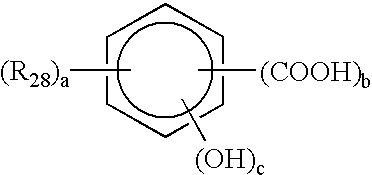Mineral gear oils and transmission fluids
a technology of transmission fluids and mineral gear oils, applied in the direction of lubricant compositions, chemistry apparatus and processes, fuels, etc., can solve the problems of reduced effectiveness of lubricants, inability to change the viscosity, and oxidation of base oils, and achieve good viscosity and oxidation properties
- Summary
- Abstract
- Description
- Claims
- Application Information
AI Technical Summary
Benefits of technology
Problems solved by technology
Method used
Image
Examples
example s-1
Sulfur (526 parts, 16.4 moles) is charged to a jacketed, high-pressure reactor which is fitted with an agitator and internal cooling coils. Refrigerated brine is circulated through the coils to cool the reactor prior to the introduction of the gaseous reactants. After sealing the reactor, evacuating to about 2 torr and cooling, 920 parts (16.4 moles) of isobutene and 279 parts (8.2 moles) of hydrogen sulfide are charged to the reactor. The reactor is heated using steam in the external jacket, to a temperature of about 182° C. over about 1.5 hours. A maximum pressure of 1350 psig is reached at about 168° C. during this heat-up. Prior to reaching the peak reaction temperature, the pressure starts to decrease and continues to decrease steadily as the gaseous reactants are consumed. After about 10 hours at a reaction temperature of about 182° C., the pressure is 310-340 psig and the rate of pressure change is about 5-10 psig per hour. The unreacted hydrogen sulfide and isobutene are ven...
example s-2
Sulfur monochloride (2025 grams, 15.0 moles) is heated to 45° C. Through a sub-surface gas sparge, 1468 grams (26.2 moles) of isobutylene gas are fed into the reactor over a 5-hour period. The temperature is maintained between 45-50° C. At the end of the sparging, the reaction mixture increases in weight to 1352 grams. In a separate reaction vessel are added 2150 grams (16.5 moles) of 60% flake sodium sulfide, 240 grams (7.5 moles) sulfur, and a solution of 420 ml. of isopropanol in 4000 ml. of water. The contents are heated to 40° C. The adduct of the sulfur monochloride and isobutylene previously prepared is added over a three-quarter hour period while permitting the temperature to rise to 75° C. The reaction mixture is heated to reflux for 6 hours, and afterward the mixture is permitted to form into separate layers. The lower aqueous layer is discarded. The upper organic layer is mixed with two liters of 10% aqueous sodium hydroxide, and the mixture is heated to reflux for 6 hour...
example s-3
The product of Example S-1 (1000 lbs.) is charged to a reactor, under medium agitation, and heat to approximately 88° C.-94° C. The reaction mixture is brought to equilibrium and the equilibrium is maintained for 30 minutes prior to collection of distillate. The reflux ratio is set at 4:1. The temperature is raised to 105° C. to ensure a steady distillation rate. Distillation is continued for approximately 20-24 hours and yields approximately 230-260 lbs. The temperature is raised to 105° C.-107° C. The system is brought to equilibrium and the equilibrium is maintained for 30 minutes prior to collection of distillate. The reflux ratio is set at 4:1. The temperature is raised to 121° C.-124° C., in order to ensure a steady distillation rate. The distillate is collected over 75-100 hours. The distillation yields approximately 300-400 lbs. of the desired product. The desired product contains 2-5% S2, 91-95% S3, and 1-2% S4.
PUM
| Property | Measurement | Unit |
|---|---|---|
| viscosity index | aaaaa | aaaaa |
| viscosity index | aaaaa | aaaaa |
| kinematic viscosity | aaaaa | aaaaa |
Abstract
Description
Claims
Application Information
 Login to View More
Login to View More - R&D
- Intellectual Property
- Life Sciences
- Materials
- Tech Scout
- Unparalleled Data Quality
- Higher Quality Content
- 60% Fewer Hallucinations
Browse by: Latest US Patents, China's latest patents, Technical Efficacy Thesaurus, Application Domain, Technology Topic, Popular Technical Reports.
© 2025 PatSnap. All rights reserved.Legal|Privacy policy|Modern Slavery Act Transparency Statement|Sitemap|About US| Contact US: help@patsnap.com



